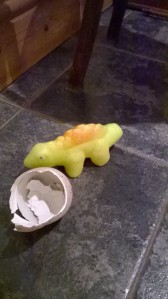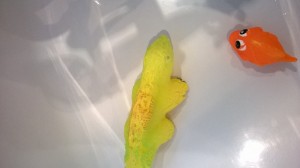 Since last June I’ve been puzzling over some ‘challenging behaviours’ which Dylan developed out of the blue after twenty years of gentleness. The behaviours began with periods during which Dylan threw himself around violently and progressed to physical attacks on others, usually focused on ears. Prior to these episodes Dylan would often go into a trance-like state and during the incidents would appear not to recognise familiar people. At these times Dylan would be ‘unreachable’ and afterwards appear exhausted and seem not to have any recollection of events.
Since last June I’ve been puzzling over some ‘challenging behaviours’ which Dylan developed out of the blue after twenty years of gentleness. The behaviours began with periods during which Dylan threw himself around violently and progressed to physical attacks on others, usually focused on ears. Prior to these episodes Dylan would often go into a trance-like state and during the incidents would appear not to recognise familiar people. At these times Dylan would be ‘unreachable’ and afterwards appear exhausted and seem not to have any recollection of events.
I have described my search for possible explanations for the behaviours, and the methods I used to document them, in previous posts (for example here and here). As my approach to working with Dylan (who doesn’t use speech to communicate and who has a significant learning disability) has always been that behaviour is communication I focused initially on environmental factors. There had been so much change in Dylan’s life that this seemed a likely explanation: in the previous few years he had experienced the death of his Gran and departure of his sister and had left education and care settings where he had been happy. Furthermore, Dylan’s provision on leaving school lacked the consistency he needed. These changes seemed a plausible explanation for Dylan’s distress.
The episodes declined following some adjustments to Dylan’s day care: full-time rather than part-time attendance, a change of support worker and an increase in Occupational Therapy all seemed to help. Other possibilities presented themselves. The ABC charts I used to analyse the behaviours suggested, for example, that they may be linked to food. Removing sugar from Dylan’s diet appeared to have an impact; the incidents which had been happening daily reduced to around once a week. I continued to puzzle, however, over behaviours which, while less frequent, became increasingly severe.
Neurological investigations
 Due to the symptoms which accompany the behaviours (the ‘absences’ and exhausted aftermath) Dylan’s GP referred him for neurological investigation. Epilepsy and schizophrenia can develop around the age Dylan is currently so I had specific concerns that Dylan’s behaviours may be due to the onset of one or both of these.
Due to the symptoms which accompany the behaviours (the ‘absences’ and exhausted aftermath) Dylan’s GP referred him for neurological investigation. Epilepsy and schizophrenia can develop around the age Dylan is currently so I had specific concerns that Dylan’s behaviours may be due to the onset of one or both of these.
It took a while for Dylan to access an appropriate clinic. The first consultant we saw had no experience with ‘non-verbal’ patients with learning disability and autism and simply shook his head. The colleague he passed Dylan onto, however, was experienced and skilled. Dylan doesn’t tolerate medical interventions (I have written about this here and here) so I knew it would be challenging if recommended. Happily, the consultant whose clinic we had arrived at understood this.
 Without medical investigations (MRI, EEG) he couldn’t say definitively but in his view, the neurologist said, Dylan probably wasn’t developing epilepsy or schizophrenia. The pattern of the episodes – their incidence and duration and Dylan’s response during and after – did not fit with the classic presentation. He couldn’t rule it out entirely – there were instances of epilepsy triggering the sorts of behaviours I had described – but these were rare.
Without medical investigations (MRI, EEG) he couldn’t say definitively but in his view, the neurologist said, Dylan probably wasn’t developing epilepsy or schizophrenia. The pattern of the episodes – their incidence and duration and Dylan’s response during and after – did not fit with the classic presentation. He couldn’t rule it out entirely – there were instances of epilepsy triggering the sorts of behaviours I had described – but these were rare.
It was much more likely that Dylan’s behaviour was a reaction to environmental factors or maturation. Puberty, the neurologist pointed out, can trigger emotional reactions which are difficult for any young person to make sense of; for Dylan, these feelings could be quite confusing. ‘He is a strong young man’, the consultant observed. ‘And you, if you will excuse me saying, are not a young woman or strong like this’. Keeping Dylan physically active would help, he told me.
I preferred to believe it was consultants who were getting younger rather than I who was getting older, I told him. But, I reassured the consultant, Dylan’s schedule was filled with OT and sports activities which, I agreed, were helpful. The consultant smiled. Then he told me how – years before, while practicing in  Germany – he had observed that the adults with learning disabilities in a institutional setting he visited exhibited challenging behaviour for 51 weeks a year. But once a year, he told me, the residents were taken on holiday where they had access to expansive grounds and were able to run free. During this week each year, he said, the behaviours disappeared.
Germany – he had observed that the adults with learning disabilities in a institutional setting he visited exhibited challenging behaviour for 51 weeks a year. But once a year, he told me, the residents were taken on holiday where they had access to expansive grounds and were able to run free. During this week each year, he said, the behaviours disappeared.
The neurologist realised (I think) that Dylan has an active life and was not intending to draw a direct comparison between Dylan and the adults in his story. What he was reflecting, however, was that behaviour is usually communication. In a follow-up letter to me he wrote: “I thought that it was most likely that the behaviours you describe are dissociative coping behaviours. I suspect that they help Dylan to deal with some form of distress… Hopefully you and Dylan’s other carers will, in time, be able to learn even more about what is likely to trigger attacks so that his care can be modified and that attacks can either be avoided or contained more effectively.”
Environmental explanations
This makes sense to me. It is also the sense which Phoebe Caldwell, in her marvellous book Finding You Finding Me (Jessica Kingsley, 2006) makes of such behaviours. It isn’t a new book but I stumbled across it (via a circuitous route through poetry and Rowan Williams) only recently. How could I have missed it? I haven’t finished reading it yet but already it has changed my world. I’ll say more about the book in a later post. For the moment I want to share just a couple of things Caldwell has to say which seem particularly pertinent:
Families may be at their wits’ end – and sometimes feeling guilty at their despair… I meet staff who are being asked to cope with impossible levels of aggression and management who are unable to come up with solutions. In many cases, person-centred planning is interpreted as how we can fit individuals into our agendas. Quite a number of the people in the most deep distress are boys fighting their way through the hormonal jungle of puberty. (pp. 25-26)
As for those whose severe learning disabilities are compounded by autism and who cannot speak for themselves, all we can do is judge from their behavioural responses to people and their environment. From the evidence of the sometimes extreme behavioural distress, one has to presume that many of them do continue experiencing fragmentation [a process arising from overload in which sensory experience breaks down ] throughout adult life. They cannot help themselves through logic and communication: their only resort is to develop coping strategies, which can so often include severe aggression. (p. 35)
 As well as Dylan’s referral to a consultant neurologist I had requested a referral to a consultant psychiatrist; while this dual track (medical and social) approach could have resulted in conflicting verdicts, happily on this occasion the professionals agreed with each other (and with Phoebe Caldwell). The psychiatrist’s preliminary assessment, like the consultant neurologist’s, is that Dylan’s behaviours are likely to be due to environmental triggers. In particular, it is suggested, Dylan’s distress is probably caused by anxiety.
As well as Dylan’s referral to a consultant neurologist I had requested a referral to a consultant psychiatrist; while this dual track (medical and social) approach could have resulted in conflicting verdicts, happily on this occasion the professionals agreed with each other (and with Phoebe Caldwell). The psychiatrist’s preliminary assessment, like the consultant neurologist’s, is that Dylan’s behaviours are likely to be due to environmental triggers. In particular, it is suggested, Dylan’s distress is probably caused by anxiety.
I have found this triangulation of professional perspectives helpful in that it has allowed me to go forwards with more confidence; a convergence of views on cause helps clarify response. In his letter to me the neurologist described Dylan’s behaviours as functional in that episodes ‘move [Dylan] on from experiencing distress to a place in which he cannot recall the distress and perhaps feels physically exhausted’. The psychiatrist has suggested that it is possible to help Dylan to ‘unlearn’ a behaviour that he has come to associate with such release from stress. At the moment Dylan is so fixated on removing my ears that the possibility I can re-direct this behaviour feels out of reach. The fact that the psychiatrist believes this is a reasonable goal, however, keeps me optimistic.
The unlearning
 I have had some unlearning of my own to do. My work in education means I am used to a cycle of monitoring, assessing, recording and reporting. Going into my initial meetings with professionals I reflected that I was probably ahead of a system which would (I presumed) require me to produce data I had already collected. It was with a sense of resignation then (not, I hope, arrogance) that in advance of the meeting I asked myself what a psychiatrist might tell me that I didn’t already know. Happily, however, there turned out to be plenty. With building interest and admiration I watched the psychiatrist bring her professional knowledge and understanding to the data I had collected. While I might be able to observe and record my son, I realised, what I didn’t have was this particular lens through which to filter the material. What I also lacked was the wide experience of other young men like Dylan which the psychiatrist could draw upon (for while Dylan may be different he could also be similar). My data charts had lots of good notes in them but they were in search of a tune; what the psychiatrist did, I reflected afterwards, was orchestrate.
I have had some unlearning of my own to do. My work in education means I am used to a cycle of monitoring, assessing, recording and reporting. Going into my initial meetings with professionals I reflected that I was probably ahead of a system which would (I presumed) require me to produce data I had already collected. It was with a sense of resignation then (not, I hope, arrogance) that in advance of the meeting I asked myself what a psychiatrist might tell me that I didn’t already know. Happily, however, there turned out to be plenty. With building interest and admiration I watched the psychiatrist bring her professional knowledge and understanding to the data I had collected. While I might be able to observe and record my son, I realised, what I didn’t have was this particular lens through which to filter the material. What I also lacked was the wide experience of other young men like Dylan which the psychiatrist could draw upon (for while Dylan may be different he could also be similar). My data charts had lots of good notes in them but they were in search of a tune; what the psychiatrist did, I reflected afterwards, was orchestrate.
The Dinosaur
 While supporting Dylan to ‘unlearn’ (inappropriate) coping responses will be useful, it is obviously preferable to modify the environment so as to reduce Dylan’s distress. The psychiatrist’s ‘orchestration’ of my observations of Dylan therefore focused on the identification of possible explanations for his anxiety. I liked the way she wove observations together to make connections I hadn’t considered.
While supporting Dylan to ‘unlearn’ (inappropriate) coping responses will be useful, it is obviously preferable to modify the environment so as to reduce Dylan’s distress. The psychiatrist’s ‘orchestration’ of my observations of Dylan therefore focused on the identification of possible explanations for his anxiety. I liked the way she wove observations together to make connections I hadn’t considered.
One issue raised, for example, was that the first occurrence of the behaviour happened while Dylan was in overnight respite the week after I had taken my first break without him (which I wrote about here). It might be the case, the psychiatrist suggested, that although Dylan appeared to cope while I was away perhaps the following week, when Dylan returned to respite care for his regular overnight stay, he was made anxious by uncertainty as to how long I would be gone.
Some of the most challenging incidents have happened while Dylan has been viewing DVDs and during the meeting we were able to link possible anxiety about separation with Dylan’s reaction to certain film sequences. One scene which seems to cause Dylan particular distress is a moment in Dinosaur when an egg becomes separated from the mother. Those involved in Dylan’s care had been aware that such scenes can trigger behaviours. We had also noted the impact of my short break on Dylan and tentatively used the word ‘separation’. What the consultant was able to do, however, was confirm that this might be relevant while at the same time signalling its necessary complexity.
Necessary Complexity
 The complexity is that we might have two dinosaurs rather than one. Because if it is the case that a son or daughter is anxious about separation, a mother’s intuitive response (especially an anxious mother) can be to avoid separation. Instead of planning for Dylan to spend increasing time away from me as preparation for leaving home, my instinct now was to keep him close. The dinosaur of anxiety could be mine, then, aswell?
The complexity is that we might have two dinosaurs rather than one. Because if it is the case that a son or daughter is anxious about separation, a mother’s intuitive response (especially an anxious mother) can be to avoid separation. Instead of planning for Dylan to spend increasing time away from me as preparation for leaving home, my instinct now was to keep him close. The dinosaur of anxiety could be mine, then, aswell?
But the psychiatrist wasn’t going to allow this; her job was to get rid of the dinosaur not let another one into the room. Dylan she said (offering another version of what the neurologist said) is in his prime; he doesn’t want to go collecting leaves with his mum. I looked at her aghast. How did she know that’s what we’d been doing at the weekend? B-b-but he likes doing that, I retorted. He liked it, she pointed out, because it was what he knew. What I needed to do was support him to do other things too, confidently and without me. In order to deal with separation anxiety, it seems, we have to learn to be separate. That will be a dinosaur of a challenge for me as much as for Dylan, I know.
The metaphor
 Shortly after the meeting my attention was caught by a ‘hatch your own dinosaur egg’ pocket money toy (for £2.99). I couldn’t resist buying it as a Christmas stocking filler for Dylan. You put the egg in a jug of cool water and increased the size of the container as the hatching progressed; perhaps looking after the egg could help re-shape Dylan’s response to the film sequence?
Shortly after the meeting my attention was caught by a ‘hatch your own dinosaur egg’ pocket money toy (for £2.99). I couldn’t resist buying it as a Christmas stocking filler for Dylan. You put the egg in a jug of cool water and increased the size of the container as the hatching progressed; perhaps looking after the egg could help re-shape Dylan’s response to the film sequence?
The egg showed no sign of life for a few days and Dylan paid no attention to it. One evening, however, a crack appeared, quickly followed by a green nose. Dylan seemed alarmed so I moved the egg from his bedroom to the kitchen where we could keep an eye on it together. The rest of our holiday was spent checking the egg. Dylan’s response shifted, slowly as a dinosaur, from anxiety about its presence to curiosity. By New Year’s Eve the birth seemed imminent and Dylan interested. If it hatches before midnight, I told him, we’ll call her Eve. If she appears tomorrow she will have to be New Year’s Day-sy.
And so it was that after twelve days Daisy was born. Since her arrival she has continued to grow as Dylan – who seems to really like her – bathes with her twice a day. Unfortunately Daisy’s skin seems to be ‘pruning’ badly (the warm water I suspect) and we may soon be faced with a tough decision about the future. Daisy may only be a metaphor, but she could be quite a useful one…
Reference:
Caldwell, P. (2006) Finding You Finding Me. Jessica Kingsley
All photographs are of Daisy.


This is fascinating and engaging. I feel for you very much.
I am reminded of some of the changing behaviours that occur with people with Alzheimer’s dementia. Sufferers can experience what appear to be personality changes, and sometimes aggression. But some health professionals think these behaviours are a logical response to anxiety caused by factors ‘normal’ people may not be able to see or understand. If neither the immediate past nor the future are functioning concepts, anxiety is inevitable. And if one is forced to do something, or pressurised at least, and that thing compounds the anxiety, aggression is one possible behavioural communication. Mute withdrawal is another.
When human beings can’t communicate in the usual way, those who CAN communicate in the usual way may misread the behavioural signs. Their ‘helping’ actions may increase the problem, while they think they are solving it. Sometimes behaviour is the only means of communication. And to make it even more complicated, the person exhibiting the behaviour may not understand the message. He or she may FEEL it but not know it linguistically or be able to reflect on it. Maybe none of this is all that far from the practice of poetry, Elizabeth!
ps. Sorry about caps. I can’t do italics in this box.
pps I was strongly affected by some of the case studies in ‘And Still the Music Plays: Stories of People with Dementia’ by Graham Stokes, 2nd ed. 2010.
LikeLike
Your comment is fascinating Nell. I don’t have experience of dementia but everything you say here makes sense to me. I wonder whether one day we will reconsider several medical diagnoses in the light of increased understanding of anxiety and its presentation. In conversation with medical professionals recently something I have heard said more than once is that the diagnoses of schizophrenia which were made of adults with autism/learning disability in the past would not be made today when we are far more likely to consider the symptoms to be anxiety. Perhaps some of what we label ‘dementia’ (and its symptoms) is, as you suggest, understandable anxiety and frustration. And I SO agree with you about helping actions sometimes exacerbating. I still have to check myself when making gestures which are intended to comfort but which actually cause Dylan discomfort. Misreading too. I do that I know. It is complicated as you say – and no, not so far from the practice of poetry! Intuition, metaphor, association, symbol and the hand-brake turn (as Kathleen Jamie describes it) are my tools for both 🙂 I will look up the Stokes book. I love that format… Thanks for reading Nell and for the really interesting comment.
LikeLiked by 1 person
Ah, anxiety. Now you’re in my territory 🙂 Although neither of my girls have the added burden of being non-verbal, the fact is that in the throes of an anxiety attack, the most usually-articulate person is rendered largely incapable of clear expression of any kind. The initial diagnosis my eldest received was, specifically, “separation anxiety,” triggered in part by her experience at age 5 of her mother being hospitalized for two months and very nearly not coming home. My youngest was 2 when my illness happened, and while she doesn’t have her sister’s conscious memories of the experience, her anxiety often exhibits in relation to separation scenarios. Neither girl has much tolerance for surprise. (“Surprise! Your mom has been flown to a hospital in another city so Grandma is taking you to daycare this morning.” — tends to leave a nasty aftertaste.) Add to that the “normal” push-pull of adolescence that my friend described as “Leave me alone but don’t go away!” There were a lot of times, especially with my eldest, that I was hard pressed to know what was the anxiety and what was good old fashioned adolescence!
LikeLike
Hi Anna – I find your reflections on parenting and anxiety really interesting. Even without the autism context, your experience often resonates for me. And hearing about *your* hospitalisation, and its impact, really brings separation into the frame. It’s interesting to me that your eldest was 5 when you became ill. Dylan’s cognitive assessments put him at developmentally around that age now and I do sometimes have to remember that some of his reactions to events will be similar to a five year old. Although my absence was nothing like yours, your comment reminds me that Dylan may be developmentally at an age to find sudden absence difficult. It must have been such a difficult time for you all. No wonder your girls don’t like surprises. I’m with them on that actually – ‘bless the quotidian’ I say – no knocks on the door or news or surprise happenings please. I’ve had my fill 🙂 I do agree with you about the anxiety/adolescence thing (especially girls!). Lizx
LikeLiked by 1 person
Thank you, Liz, for giving such an interesting and detailed picture (once again) of the investigations into Dylan’s behaviour. It’s good to hear that the professionals you mention have helped you to contextualise what Dylan might be trying to communicate about his feelings. It seems, from what you say, that it is both reassuring and challenging to know that you are right about Dylan’s level of anxiety but also need move the situation or context on, in order to change the pattern of his behaviour. It would be surprising if you were not anxious about the changes this might mean and I’m looking forward to hearing what the next step will be for you both. I know you’ll manage it well, whatever it is.
LikeLike
Thanks Caroline – much appreciated. I think you’re right – it is reassuring to be clearer that anxiety is probably beneath the behaviours but still challenging to respond. It does occur to me that I may never know what the source of some of the anxiety is because presumably I’m looking for the sorts of things we associate with anxiety which may be quite different for Dylan. And perhaps some of it will fade without my ever knowing what it was. Which of course means I can’t avoid the trigger in the future. It can feel a bit like playing slot machines sometimes. Not that I do 🙂
LikeLike
Hi Liz
We once worked together in a dysfunctional Education Department in the city and I was recommended your bog by a mutual friend and colleague who lives in the same village as me close to Sheffield when I told her about my autistic 5year old grandson.
Since autumn, I have been catching up on you and Dylan via this BLOG and am filled with admiration for your careful teaching strategies and accompanying commentary on Dylan’s life . It’s inspiring. I also find your poetry is especially poignant as it resonates with my growing awareness of our little Ivan’s early life. Thank you. I’d loe to meet you sometime if you came walking in Derbyshire. There’s a Deli here where it’s good to chat over coffee.
I gave my BLOG up ages ago but amon the brink of restarting.
LikeLike
Hi Elaine –
It’s lovely to hear from you. I remember that Department 😦 K mentioned to me that your grandson had received a diagnosis and that she’d told you about my blog. I’m glad you’ve found it helpful and thank you for the lovely feedback. I couldn’t possibly have done it when Dylan was the age Ivan is now. I was still in pieces and quite lost. The internet was just emerging and although I did access it (as you may remember my ex-husband is an elearning man) there wasn’t the information available there is now. It has taken me many years to get to a place I see some parents of newly-diagnosed children find relatively quickly. And actually life with Dylan still feels a bit like writing a poem; fresh starts each time with as many opportunities for failure as success 🙂 Anyway it would be lovely to meet up – coffee in H sounds good. I’m working 0.8 this year so am flexible (K will pass on my email if you can’t find). It would be good to hear a little about your life with Ivan – I think Grandmothers are so important and can have a very enabling relationship where autism is involved. Dylan adored my mum. I’m sure Ivan feels lucky to have you 🙂 p.s. I’m wondering what the focus of your blog was? Literacy? Glass ceilings and academia? Or something else? Let me know when you re-start! p.p.s. I think wordpress has a tendency to introduce errors in typing – bog for blog is great 🙂 Liz x
LikeLike
Ps
When I reread I see I’ve skipped characters in places. Please substitute ‘blog’ for ‘bog’; ‘love’ for ‘loe’ ‘am on’ for amon
Elaine
LikeLike
Pingback: Mother And Son In Aspect Ratio 1:1 | Living with Autism
Pingback: And Finally | Living with Autism